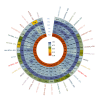[Forensic performance and genetic background analyses of Guizhou Chuanqing population using a self-constructed microhaplotype panel]
- PMID: 40673306
- PMCID: PMC12268925
- DOI: 10.12122/j.issn.1673-4254.2025.07.10
[Forensic performance and genetic background analyses of Guizhou Chuanqing population using a self-constructed microhaplotype panel]
Abstract
Objectives: To investigate the ethnic origin of Chuanqing people, one of the largest unidentified ethnic groups in Guizhou, China, and analyze its genetic relationships with surrounding populations.
Methods: Based on a self-developed microhaplotype system, we conducted genotyping and analyzed the genetic distribution of microhaplotype loci and their forensic applicability in Chuanqing population in Guizhou Province. Using the microhaplotype data from different intercontinental populations and previously reported data from Han population living in Guizhou Province, we systematically investigated the genetic background of Chuanqing people through population genetic approaches, including genetic distance estimation, principal component analysis, and phylogenetic tree construction.
Results: Among the studied population, the number of haplotype per microhaplotype ranged from 6 to 25. The average expected heterozygosity (He), observed heterozygosity (Ho), power of discrimination (PD), and probability of exclusion (PE) were 0.8291, 0.8301, 0.9387, and 0.6593, respectively. The cumulative power of discrimination (CPD) and cumulative probability of exclusion (CPE) for these 33 loci were 1-2.62×10-41 and 1-7.64×10-17, respectively. Population genetic analyses revealed that the Chuanqing population had close genetic relationships with the East Asian populations, especially the local Guizhou Han population, Beijing Han population and the Han populations living in southern China.
Conclusions: The 33 microhaplotypes exhibit high levels of genetic diversity in the Guizhou Chuanqing population, highlighting their potentials for both forensic identification and parentage testing. The Han populations might have contributed a significant amount of genetic material to the Chuanqing population during the formation and development of the latter.
目的: 评估一组微单倍型位点在贵州穿青人中的法医学应用效能,并基于既往报道的数据探讨穿青人与周边族群的遗传关系。方法: 基于自主研发的一个微单倍型分型检测体系,对贵州穿青人进行检测分析,评估微单倍型位点在穿青人中的遗传分布和法医学应用效能。基于不同洲际群体以及既往报道的贵州汉族群体的微单倍型数据,采用遗传距离、主成分分析(PCA)、系统发育树等群体遗传分析方法系统探讨穿青人的遗传背景。结果: 在穿青人群中,33个微单倍型位点的单倍型数为6~25个,平均期望杂合度(He)、观测杂合度(Ho)、个体识别能力(PD)和非父排除概率(PE)分别是0.8291、0.8301、0.9387和0.6593。33个位点的累积个体识别能力(CPD)和累积非父排除概率(CPE)分别是1-2.62×10⁻41和1-7.64×10⁻17。群体遗传分析结果表明,穿青人与东亚人群具有密切的遗传相关性,尤其和贵州本地汉族、中国南方汉族和北京汉族。结论: 33个微单倍型在贵州穿青人群中表现出高度的遗传多态性,可作为一个高效的工具用于穿青人的法医学个人识别和亲缘鉴识研究。此外,汉族群体可能在穿青人的形成与发展过程中贡献了主要的遗传成分。.
Keywords: Chuanqing population; forensic performance; genetic structure; microhaplotype.
Conflict of interest statement
The authors declare no competing interests.
Figures







Similar articles
-
Development and evaluation of a panel of newly screened Y chromosome InDels for inferring paternal ancestry information in Southwest China.Int J Legal Med. 2025 Jan;139(1):27-39. doi: 10.1007/s00414-024-03344-7. Epub 2024 Oct 8. Int J Legal Med. 2025. PMID: 39377930
-
Selection of microhaplotype loci and development of panel for forensic application.J Forensic Sci. 2025 Jul 18. doi: 10.1111/1556-4029.70139. Online ahead of print. J Forensic Sci. 2025. PMID: 40682217
-
Forensic efficiency evaluation of a novel multiplex panel of InDels and STRs in the Guizhou Han population and its phylogenetic relationships with other reference populations.Ann Hum Biol. 2023 Feb;50(1):42-47. doi: 10.1080/03014460.2023.2168754. Ann Hum Biol. 2023. PMID: 36636013
-
Signs and symptoms to determine if a patient presenting in primary care or hospital outpatient settings has COVID-19.Cochrane Database Syst Rev. 2022 May 20;5(5):CD013665. doi: 10.1002/14651858.CD013665.pub3. Cochrane Database Syst Rev. 2022. PMID: 35593186 Free PMC article.
-
The effect of sample site and collection procedure on identification of SARS-CoV-2 infection.Cochrane Database Syst Rev. 2024 Dec 16;12(12):CD014780. doi: 10.1002/14651858.CD014780. Cochrane Database Syst Rev. 2024. PMID: 39679851 Free PMC article.
References
-
- Yan Q. Distribution characteristics and historical causes of unreco-gnized ethnic populations in Guizhou [J]. Popular Business, 2009, (2): 27-31.
-
- 李良品. 贵州方志中有关“穿青人” 及其先民族源和族称的记载[J]. 贵州民族研究, 2011, 32(2): 159-66.
-
- 黄锦树. 贵州穿青人族属考析: 与畲族同出古帝少昊[J]. 韩山师范学院学报, 2013, 34(1): 21-9.
Publication types
MeSH terms
Grants and funding
LinkOut - more resources
Full Text Sources
Research Materials
Miscellaneous
